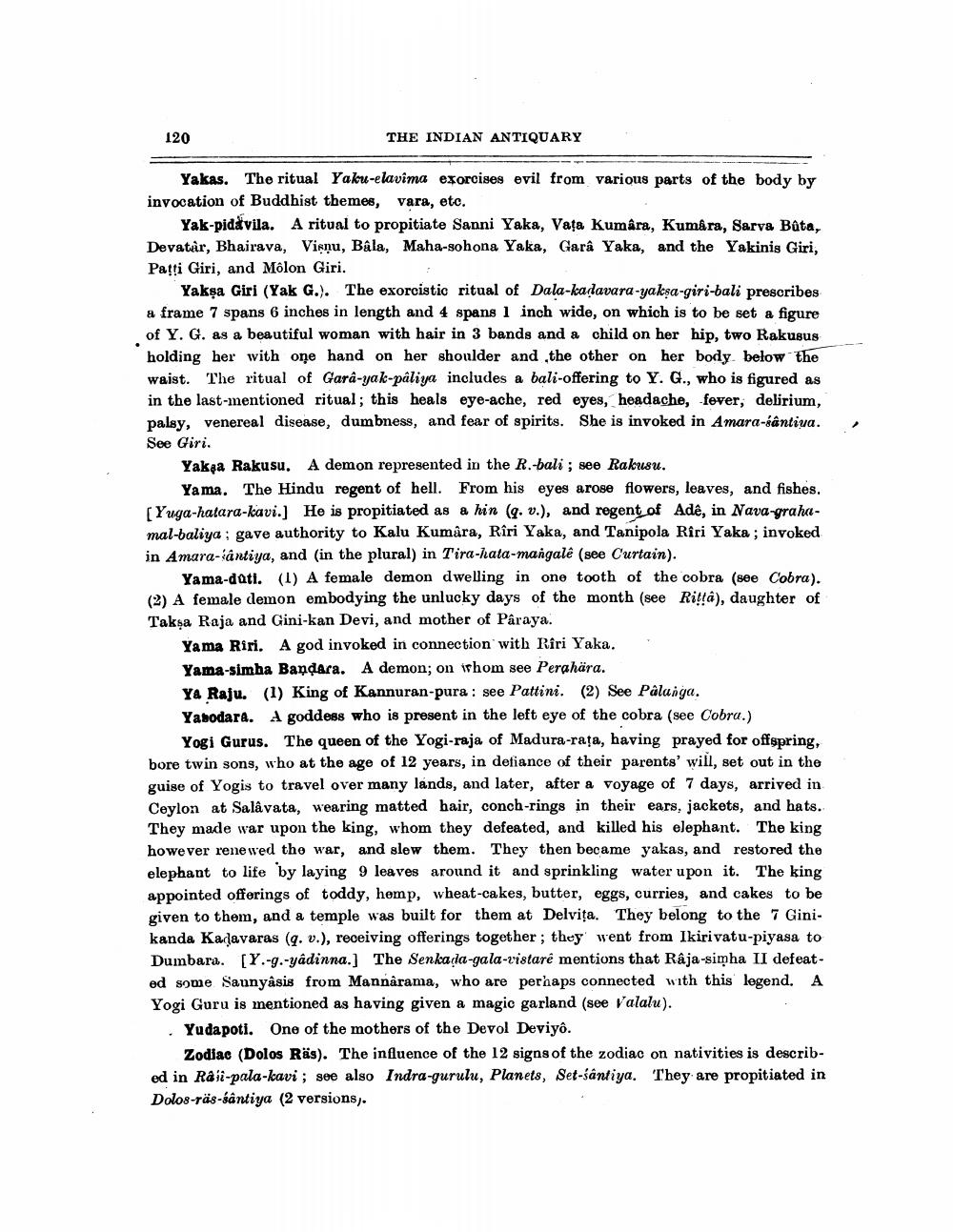________________ 120 THE INDIAN ANTIQUARY Yakas. The ritual Yaku-elavima exorcises evil from various parts of the body by invocation of Buddhist themes, vara, etc. Yak-pidavila. A ritual to propitiate Sanni Yaka, Vata Kumara, Kumara, Sarva Buta, Devatar, Bhairava, Visnu, Bala, Maha-sohona Yaka, Gara Yaka, and the Yakinis Giri, Patti Giri, and Molon Giri. Yaksa Giri (Yak G.). The exorcistic ritual of Dala-kadavara-yaksa-giri-bali prescribes a frame 7 spans 6 inches in length and 4 spans 1 inch wide, on which is to be set a figure of Y. G. as a beautiful woman with hair in 3 bands and a child on her hip, two Rakusus. holding her with one hand on her shoulder and the other on her body below the waist. The ritual of Gara-yak-paliya includes a bali-offering to Y. G., who is figured as in the last-mentioned ritual; this heals eye-ache, red eyes, headache, fever, delirium, palsy, venereal disease, dumbness, and fear of spirits. She is invoked in Amara-santiua. See Giri, Yakca Rakusu. A demon represented in the R.-bali ; see Rakusu. Yama. The Hindu regent of hell. From his eyes arose flowers, leaves, and fishes. [Yuga-hatara-kavi.] He is propitiated as a hin (q. v.), and regent of Ade, in Nava-grahamal-baliya ; gave authority to Kalu Kumara, Riri Yaka, and Tanipola Riri Yaka ; invoked in Amara-santiya, and in the plural) in Tira-nata-mangale (see Curtain). Yama-dati. (1) A female demon dwelling in one tooth of the cobra (see Cobra). (2) A female demon embodying the unlucky days of the month (see Ritta), daughter of Taksa Raja and Gini-kan Devi, and mother of Paraya. Yama Riri. A god invoked in connection with Riri Yaka. Yama-simba Bandara. A demon; on irhom see Perahara. YA Raju. (1) King of Kannuran-pura : see Pattini. (2) See Palanga. Yabodara. A goddess who is present in the left eye of the cobra (see Cobra.) Yogi Gurus. The queen of the Yogi-raja of Madura-rata, having prayed for offspring, bore twin sons, who at the age of 12 years, in defiance of their parents' will, set out in the guise of Yogis to travel over many lands, and later, after a voyage of 7 days, arrived in Ceylon at Salavata, wearing matted hair, conch-rings in their ears, jackets, and hats. They made war upon the king, whom they defeated, and killed his elephant. The king however renewed the war, and slow them. They then became yakas, and restored the elephant to life by laying 9 leaves around it and sprinkling water upon it. The king appointed offerings of toddy, hemp, wheat-cakes, butter, eggs, curries, and cakes to be given to them, and a temple was built for them at Delvita. They belong to the 7 Ginikanda Kadavaras (9.v.), receiving offerings together; they went from Ikirivatu-piyasa to Dumbara. [Y.-g--yadinna.] The Senkada-gala-vistare mentions that Raja-simha II defeated some. Saunyasis from Mannarama, who are perhaps connected with this legend. A Yogi Guru is mentioned as having given a magic garland (see Valalu). Yudapoti. One of the mothers of the Devol Deviyo. Zodiae (Dolos Ras). The influence of the 12 signs of the zodiac on nativities is describod in Raii-pala-kavi ; see also Indra-gurulu, Planets, Set-santiya. They are propitiated in Dolos-ras-santiya (2 versions).




